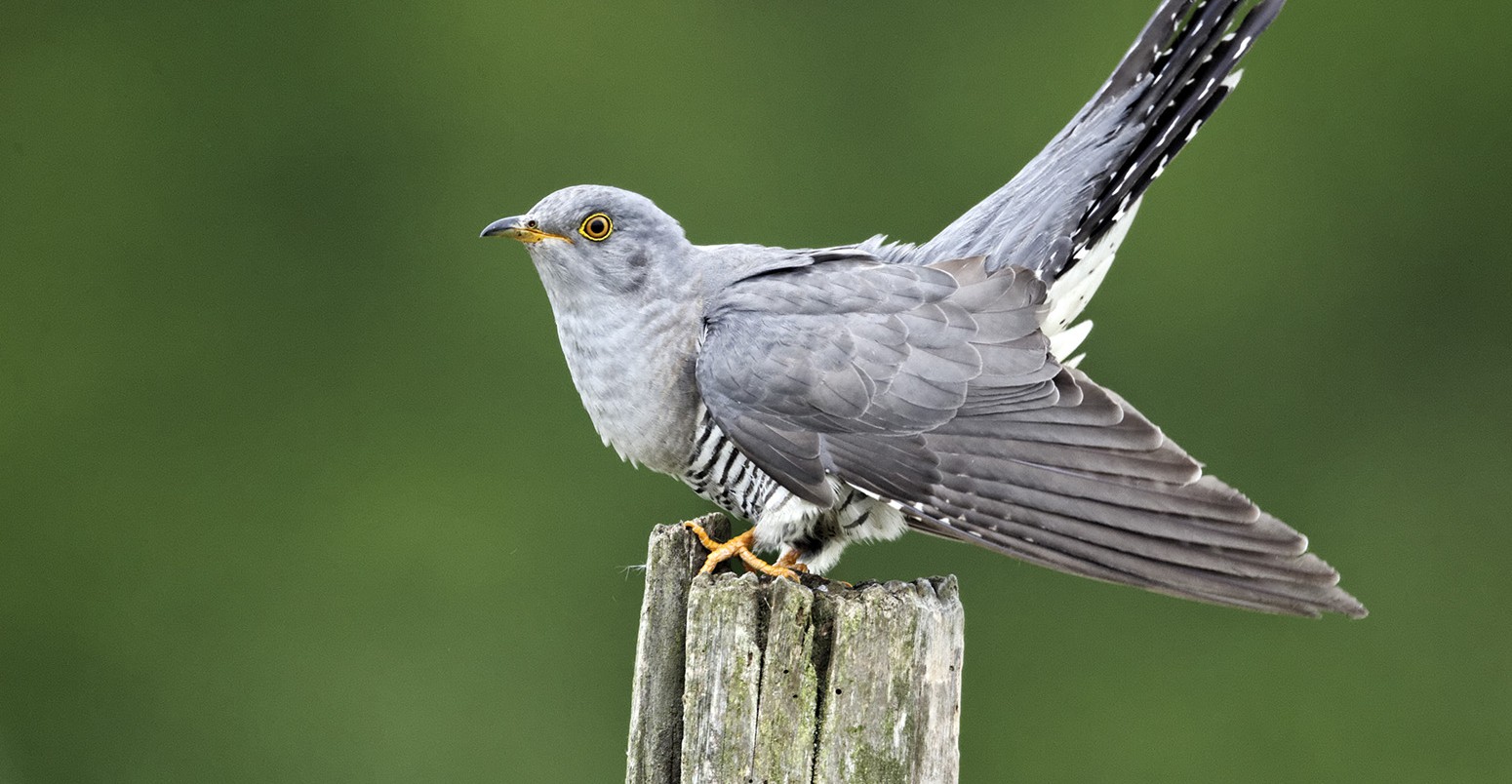
Iconic British birds and wildlife at risk from climate change
Roz Pidcock
07.23.15Roz Pidcock
23.07.2015 | 12:05pmScientists have found that 27% of England’s plants and animal species will be put at risk as temperatures climb, including some of the nation’s best known birds.
A new report from Natural England finds that the cuckoo, peregrine, short-eared owl and barnacle goose all face very high risk of decline with 2C of warming.
The nationwide study of more than 3,000 species has attracted a fair bit of media coverage today. The BBC focuses on the risk posed to British birds, especially the curlew. The Express says species in the north of the country will fare better than their southern counterparts.
Grahame Madge from the Royal Society for the Protection of Birds (RSPB) tells Carbon Brief:
But not all species will suffer, as today’s Times points out. Garden favourites, such as the house sparrow, skylark, song thrush, blackbird and starling, will be reasonably unaffected. Meanwhile, wasps, bees and ants look set to flourish as temperatures rise, the research notes.
Climate ‘envelope’
Plants and animals have a range of conditions in which they can live comfortably. For some, that range is small, making them vulnerable to slight changes in their environment. Others are less sensitive, being better able to tolerate a wider range of conditions.
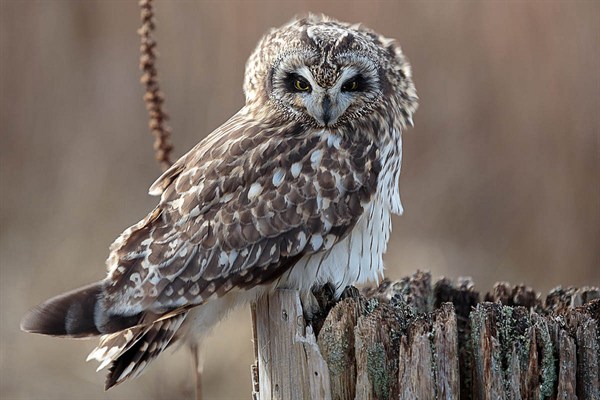
Short-eared owl | gbrazzil/flickr.
Since there is no one-size-fits-all rule, scientists need to examine how climate change is likely to affect individual species across the UK, and then combine them to get an overall picture.
Natural England, the government’s adviser for the natural environment in England, looked at how populations of 3,048 plant and animal species are distributed at the moment, and how each one’s ‘envelope’ of habitable conditions is likely to change in future.
The scientists used the UKCP09 projections, which expect average temperature in the UK to rise by 2-7C by the end of the century. The bottom of that range is achievable only with stringent mitigation, while the top is what scientists expect if if fossil fuel emissions stay very high.
Risks and opportunities
Of the 3,048 plant and animal species considered in the study, 27% would be at medium or high risk of climate change with just 2C of warming.
The graph below shows a breakdown of how different species are likely to be affected. Species most at risk are vascular and nonvascular plants, known as bryophytes, with more than 30% of species classed as facing high (red) or medium risk (orange).
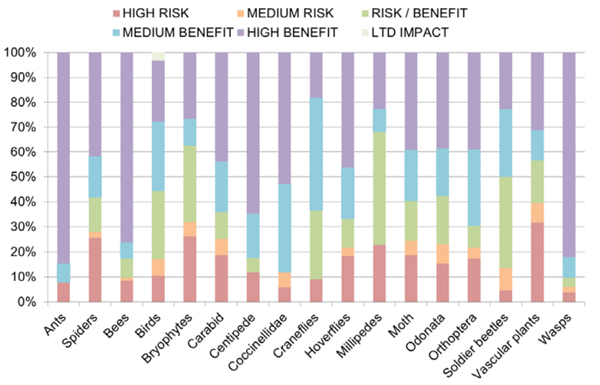
Proportion of species likely to face high (red) and medium risk (orange) from climate change and those likely to face medium (blue) and high (purple) opportunity. Data from all 3,048 species. Source: Pearce-Higgins, J.W. et al. (2015).
Unsurprisingly, perhaps, species that are affected at 2C are even more impacted at 4C. But the difference between the two scenarios is less than the difference between the current climate and both future projections, the study notes.
For some species, warmer temperatures may bring an opportunity to increase in numbers or extend their ranges. The biggest beneficiaries are likely to be wasps, ants, bees and centipedes, as you can see by the large purple bars in the graph above.
In total, just over half of species (54%) are expected to experience some kind of opportunity from rising temperatures, the report notes. But this isn’t the good news that it sounds since “generalist” species are tending to increase at the expense of “specialist” ones, the report says:
A more realistic picture
While 3,048 species is the greatest number ever considered in an analysis of this kind, these numbers represent a very basic assessment of future risk. They doesn’t take into account factors that can limit how successfully a species can adapt to rising temperatures, the report notes, such as the availability of suitable habitat and potential interactions with other species.
For a more realistic estimate, the scientists looked more closely at a subset of 402 plant and animal species for which enough data exists on all these other factors. This included 155 species labelled a priority by the Natural Environment Research Council ( NERC).
This reveals a very similar-looking plot to the one above, but with the number of species facing medium and high risk rising by 8% and the number likely to benefit falling by 12%.
The picture for plants looks even bleaker, with more than 70% of bryphytes at risk or high risk from 2C warming. At least 30% of spider, millipede, moth, dragonfly, damselfly, soldier beetle and more than 50% of hoverfly species are regarded as being at risk of climate change.
Upland habitats are the most vulnerable to climate change, with more than 60% of species at medium or high risk compared to 30% in most other habitats.
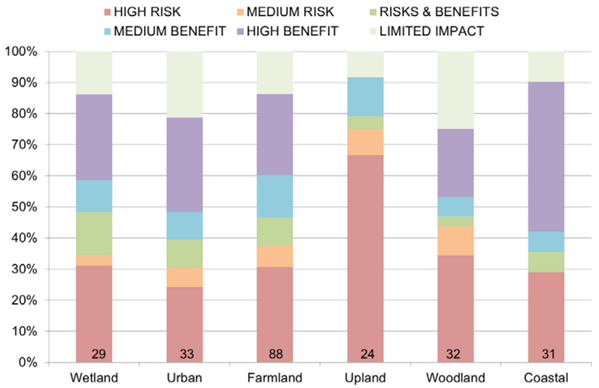
Proportion of species categorised as facing risks and opportunities from climate change, according to habitat type. Data from a subset of 402 species, including 155 species classified by NERC as ‘at risk’. Source: Pearce-Higgins, J.W. et al. (2015).
Iconic birds
More than 30% of bird species are likely to be put at risk from rising temperatures, the results show. The cuckoo, curlew tree pipit, wood warbler, peregrine, short-eared owl and barnacle goose all face very high risk of decline with 2C warming.
But there are likely to be broadly similar numbers of winners and losers with 2C, the report notes. Among the most likely to benefit are the bittern, herring gull, nightjar, spotted crake, cormorant and Cetti’s warbler. But Madge tells Carbon Brief:
Take the red-necked phalarope, says Madge. The Shetland Islands mark the southernmost part of the birds’ habitat in the northern hemisphere. Without proper care, rising temperatures could push the species out of the UK altogether. Or take the capercaillie, the world’s largest grouse, whose range is confined to Scotland. Preserving the Caledonian pine forests on which the birds rely will help buffer the iconic species against the effects of climate change, Madge says.
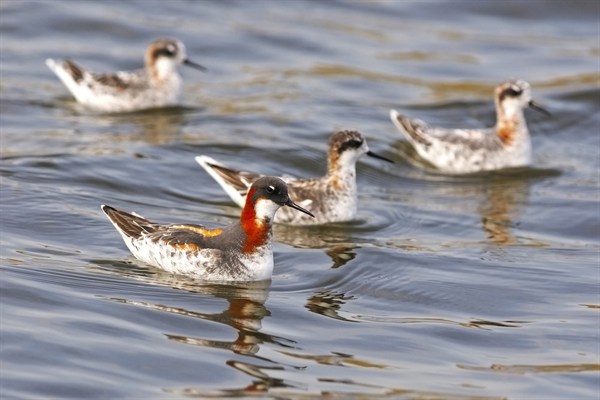
Red-necked phalarope | Shutterstock
Garden favourites, including the house sparrow, skylark, song thrush, blackbird and starling, as well as turtle doves, green and great spotted woodpecker, house martin, kestrel and wren, are unlikely to experience either a significant risk or opportunity, the results suggest.
Conservation priority
The researchers acknowledge that their projections come with some degree of uncertainty, but that they are comprehensive enough to show the direction and size of changes that are likely.
Importantly, as well as highlighting the impacts of climate change, the report identifies which species and which habitats should be the biggest conservation priorities, says Madge.
Main image: Cuckoo, Cuculus canorus, single bird on post, Midlands, April 2011. Credit: Erni/Shutterstock.
Pearce-Higgins, J.W. et al. (eds). 2015. Research on the assessment of risks & opportunities for species in England as a result of climate change. Natural England Commissioned Reports, Number 175.
-
Scientists have found that 27% of England's plants and animal species will be put at risk as temperatures climb, including some of the UK's best known birds

